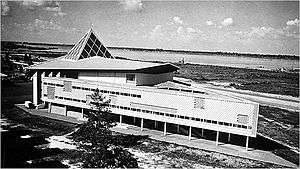Preah Suramarit National Theatre

The Preah Suramarit Theatre or the Bassac Theatre is the former national theatre of Cambodia in the capital Phnom Penh.[1]
Designed by chief national architect Vann Molyvann in 1966, it opened in 1968 as the Grand Théâtre Preah Bat Norodom Suramarit (aka Mohorsrop Theatre). Built to resemble a ship on the banks of the Bassac River, the venue was known for its wide stage and excellent acoustics for Cambodian drama and musicals.[1] The theatre building became a landmark structure in modern Phnom Penh. It was demolished in 2008.[2]
History
Before Pol Pot, at least 300 artists were professionally engaged at the Bassac theatre to give fairly regular performances of classical and folk dance, bassac opera, yike, spoken theatre, acrobatics and live music. About 80 percent never returned. During the 1980s, the Ministry of Culture made a concerted effort to identify and lure all surviving musicians back to Phnom Penh, triggering the beginnings of a cultural revival punctuated with a 1988 festival inside a Bassac Theatre which had been little affected by the wars.[3]
Fire and reconstruction efforts
However, in February 1994, during renovation efforts, there was disastrous fire that gutted the entire auditorium and the venue has remained a burned-out shell ever since.
At the time of the fire, the building was not insured and the culture minister at the time, Nouth Narang, who had not signed any contract with the French company carrying out the renovation work, immediately launched an appeal for $12 million to rebuild the theatre. The minister reportedly offended the International Technological Committee overseeing the renovation and with it the French Embassy that had put up the money by inferring that arson was involved, or at the very least incompetence of the welders. The arson claim was perhaps given credence by one man's claim that he had been paid 500 Thai baht to set the fire.
Despite the devastating consequences of the fire, the lobby continued to be used on a daily basis for Khmer classical dance practice by the National Theatre Company of Cambodia, which was based at the Directorate of Performing Arts to the rear of the building.[4]
Since the late 1990s, there have been many unsuccessful efforts to seek funds for the restoration of the theatre and to redevelop it as an organisational base and national venue. Whilst a $20,000 project by the late Cambodian architect Brum Dar-ravudh, providing the facilities for several rehearsal spaces the National Theatre's head, Mao Keng, a former dancer, has aimed to build a brand-new, state-of-the-art building, which has been rejected by the Cambodian Council of Ministers. A more ambitious project for a completely new theatre that including dressing rooms, a cafeteria and a swimming pool was proposed in 1999 but never got the green light.[5]
Sisowath Kulachad, speaking on behalf of Culture Minister Prince Sisowath Panara Sirivuth, said in November 2004 that Prime Minister Hun Sen and National Assembly President Norodom Ranariddh had conceived a plan to create a new, much expanded theatre. It would cost between $28 and $30 million and be situated in the middle of Boueng Kak Lake. Despite this, the plans soon diminished from media attention.
In the ensuing years, neither the Ministry of Culture nor any of the Cambodian cultural or political establishments were able to raise the finances to restore the theatre and succeed with the proposals resulting in a stalemate.
In early 2005 the disposal of the theatre site was given to a local developer and business man, Mr Kith Meng, who later executed its complete destruction.
Filmmaker Rithy Panh's 2005 docudrama, The Burnt Theatre, is set in the remains of the theatre, and depicts a theatre troupe struggling to practice their art and keep fine arts alive in Cambodia.